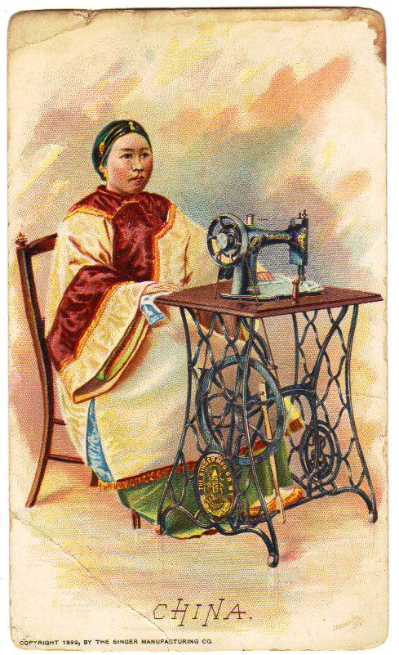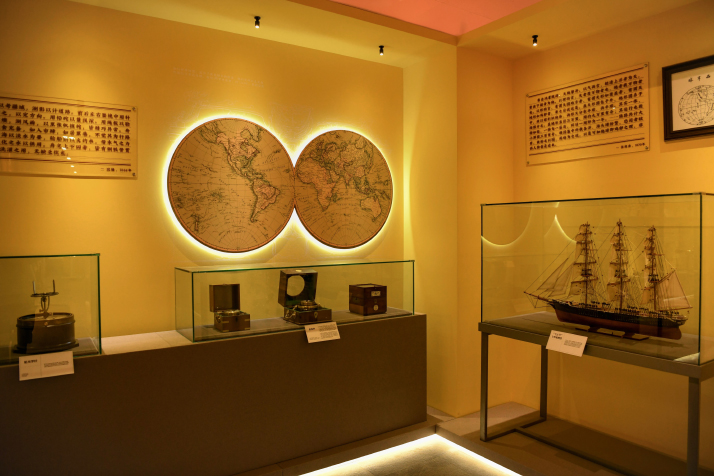| China |
| Stepping into the world of 19th-century science and technology | |
|
|
 The advertisement card of a Singer sewing machine designed for the Chicago World Fair in 1893, inspired by upper-class women of the Qing Dynasty (1644-1911), to whom the machines were exported at the time (COURTESY PHOTO)
Fabulous voyagers! What histories Are there behind your deep and distant stare! Show us the treasures of your memories, Those jewels and riches made of stars and air. French poet Charles Baudelaire (1821-67) wrote these lines in his poem Le Voyage (The Journey in English) to express his admiration for those who had ventured far and seen things hiding well beyond the horizons of their own lives. Baudelaire marveled at the stories told through travelers' eyes. In the late 19th century, several undaunted Qing Dynasty (1644-1911) explorers left their homeland to discover the Western world—a world of advanced technologies which posed a stark contrast to their familiar surroundings. They documented their observation and usage of different exotic objects. Identical artifacts collected overseas are now on display at Beijing's renowned Tsinghua University in an exhibition titled Wonderful Instruments From Overseas: The Western Technological World in the Eyes of Late Qing Intellectuals. The exhibition will run from March to the end of this year. Organized by the university's Department of the History of Science, the exhibition features original objects from the early 19th century epitomizing the cutting-edge science of the time, including transportation models, phonographs, cameras, microscopes, and many more. But this display is much more than a retrospective on history; it serves as a mirror for modern society to reflect upon itself. "China made countless scientific contributions to the world in ancient times and the Chinese civilization has consistently evolved through exchange and mutual learning with other civilizations around the world," Lou Wei, Executive Deputy Curator of the Palace Museum, also known as the Forbidden City, which housed China's imperial palace from the 15th century to the early 20th century,commented at the exhibition's opening ceremony on March 20. "This exhibition demonstrates how open-minded people in the late Qing proactively explored the world's latest developments and sought to prosper China through science and technology," Lou said. The third perspective Divided into five sections—Land and Water Transportation, Street Scenes, Western Devices, Popular Science and The Study of Gezhi ["Science" in English], Tsinghua's undertaking is unique in its adoption of a third perspective: conveying to visitors the voyagers' feelings upon seeing and using the unfamiliar objects. "After reading dozens of documents, I realized that the people who went abroad in the late Qing, mostly political elites, followed similar itinerary to the one we usually follow today," Wang Jing (Jocelyn), the exhibition's initiator, told Beijing Review. "They took transportation, strolled through streets, took photos, visited famous landmarks or attractions, explored public institutions like museums, universities, libraries and observatories, and so forth," she added. To enable audiences to really immerse themselves in the travelers' experiences and follow in their footsteps, Jocelyn designed and categorized the sections to precisely mirror this "typical itinerary." "It is created to offer visitors a time-travel-like experience," she said. The objects on display are accompanied by their onlookers' comments, written in classical Chinese, the standard written language for ancient China's scholars and officials. "Today, with these lively descriptions in place, our audiences can take in the Qing travelers' perspectives from new, modern angles—a third perspective, so to speak, " Jocelyn elaborated. While the exhibition mainly focuses on technology, many objects also involve interdisciplinary knowledge, such as the history of modern diplomacy, sociology and the exchange of science and technology between China and the West. One example is that of the hand-crank sewing machine, arguably a protagonist in social reform and the evolution of women's roles in society. Invented in the late 19th century, this sewing machine aimed to decrease manual labor in clothing production and enhance efficiency in the textile sector. The hand-crank sewing machine indeed revolutionized the textile industry, but also empowered women in general by offering a tool for economic independence and increased autonomy over their time and resources. According to a report published in the British Manchester Guardian newspaper (known today as The Guardian) on August 19, 1896, Li Hongzhang, a famous Qing diplomat, visited a sewing machine factory during his trip to England and even tried his hand, and foot, at differently operated machines. The factory manager then gifted Li two sewing machines. He kept one and presented the other to Empress Dowager Cixi, the de facto ruler of China for nearly five decades until her death in 1908. In those days, hand-crank sewing machines were very much status symbols for upper-class women in Asian countries where they were imported.  Technological innovations of the 19th century from Western countries, along with their descriptions written in classical Chinese, are on display at the exhibition (COURTESY PHOTO)
Exploration en route "We want to initiate deeper interaction between audience and objects through state-of-the-art planning, so the exhibition team designed many small interactive sections which you will find scattered across this exhibition," Jocelyn said. Examples thereof include Morse code quizzes, stereoscopic mirrors tailored to both children and adult heights, high-definition replicas of slides and the original recordings of wax cylinder records. Additionally, a wall featuring magnetic suction boards allows enthusiasts to flip over the boards to reveal detailed sketches of the objects on display and capture some memorable photos. "To further impress science enthusiasts, we have a dedicated reading section," Jocelyn continued. "We stocked the shelves with historical books about science, related dissertations from Tsinghua teachers and students, as well as offer science popularization comics for our younger audiences." The exhibition is part of the broader vision for the Tsinghua University Science Museum, the first comprehensive university museum dedicated to scientific collections in China, the creation of which was first announced in 2018. The museum will be ready to open its doors to the public by 2027, with the goal of showcasing scientific achievements and fostering the public's engagement with science. But prior to its opening, the museum has already organized 18 related events since 2019. These included forums, exhibitions and lectures aimed at updating visitors on the latest developments in science and providing educational opportunities for the public. "The museum is currently also working with the Palace Museum on an exhibition on scientific relics from the Qing court," Jocelyn said. "This exhibition will be staged inside the museum's designated exhibition hall. This hall is also set to serve future cooperation with museums from all over the world." "The preparatory work for the Tsinghua University Science Museum is on stable track, including the restoration of cultural relics, designing exhibition halls, creating social media accounts, recruiting volunteers, etc. We want this museum to become a science popularization platform as well as a teaching base for our students," Wu Guosheng, Dean of Tsinghua's Department of the History of Science, said at the exhibition's opening ceremony. Copyedited by Elsbeth van Paridon Comments to zhangyage@cicgamericas.com |
|
||||||||||||||||||||||||||||||
|
